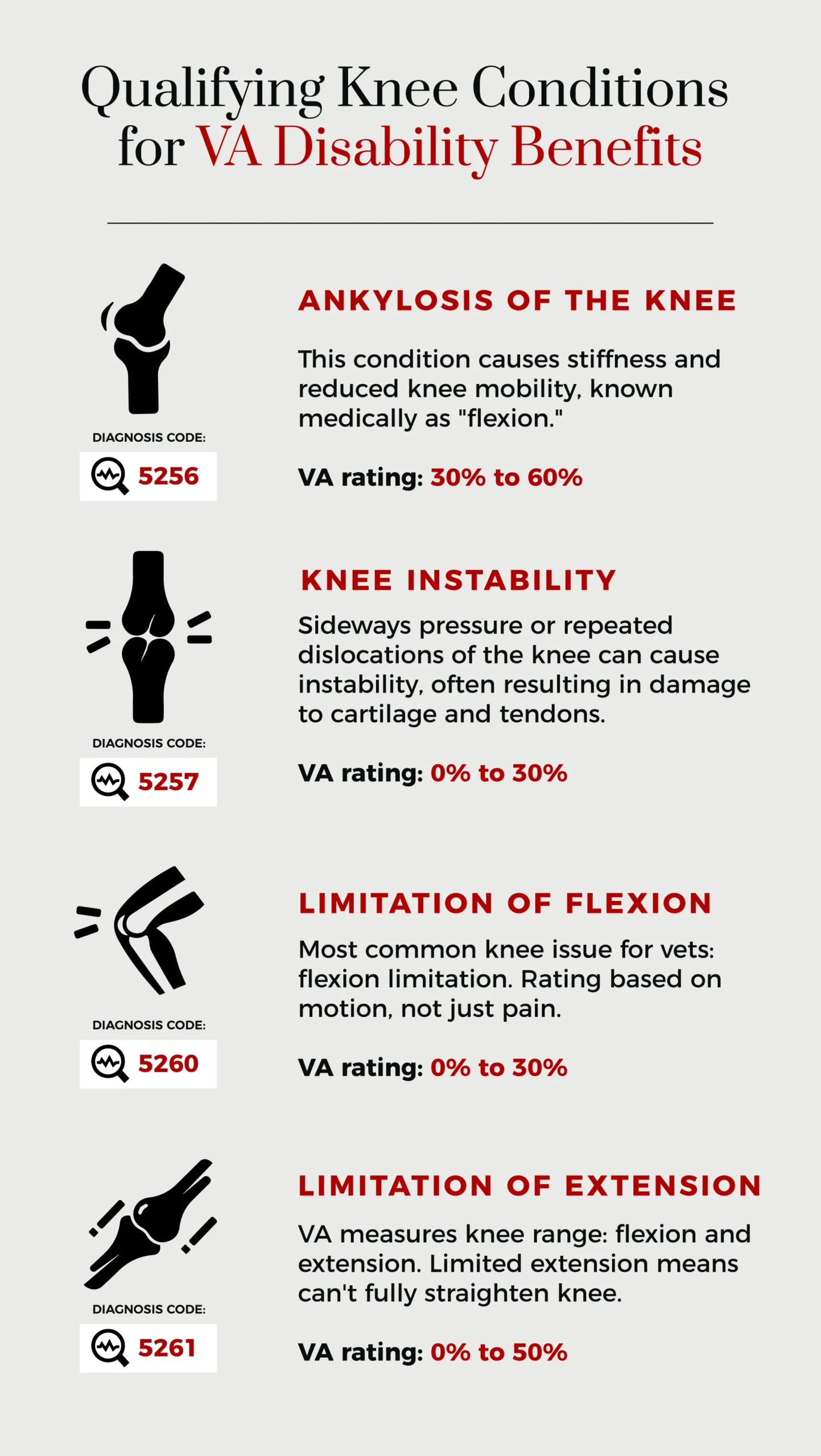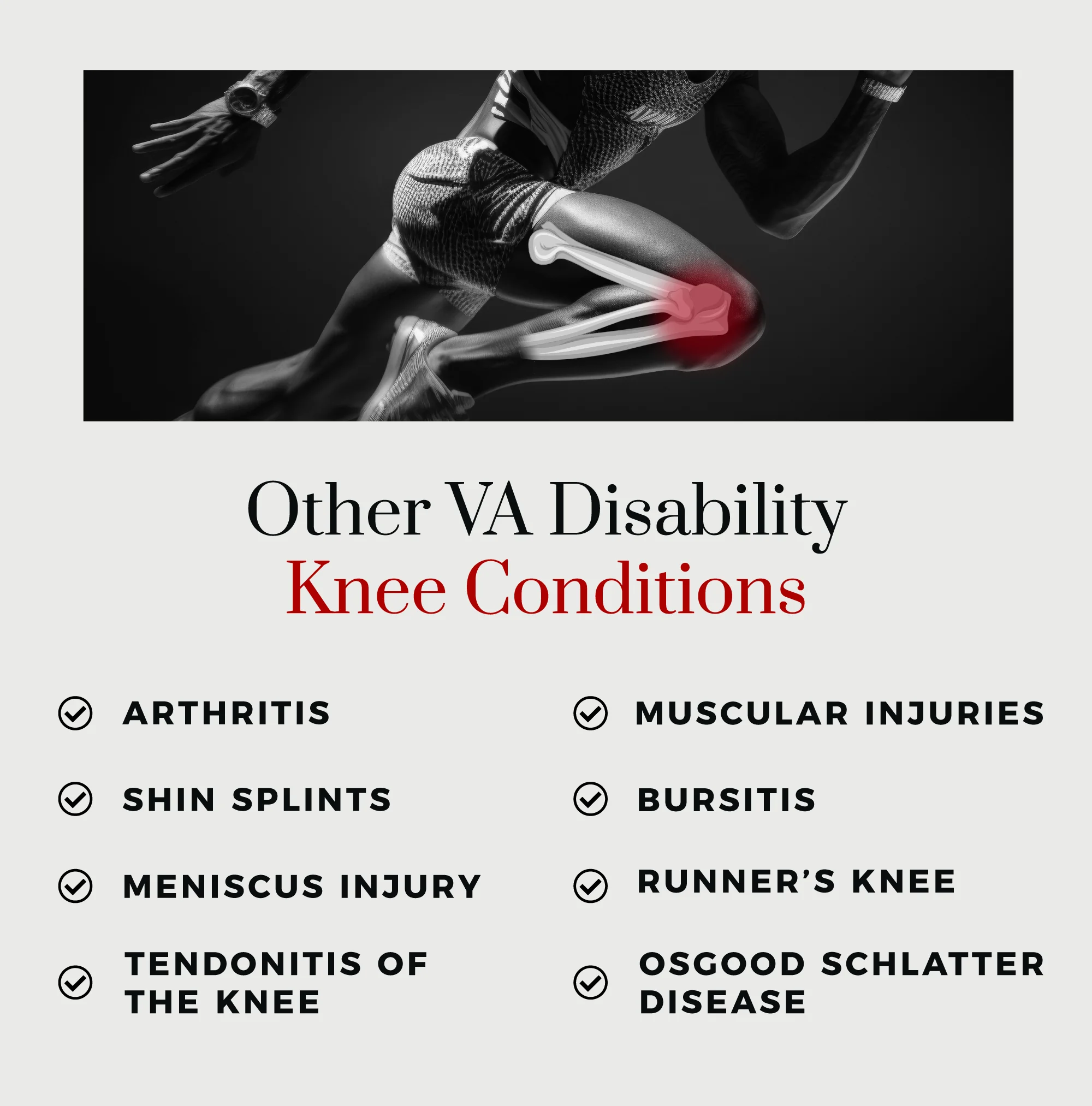Determining your VA rating for knee pain depends on the type of injury you have and its severity, but generally, it ranges from 0% to 60%. Below, we’ll list common knee conditions and the range of ratings the VA applies to them. It is also possible to reach 100% temporary disability post-surgery.
To obtain the benefits you deserve, having an experienced VA disability compensation attorney to help you can save you time, frustration, and even increase your chances of success. The VA disability lawyers at Stone Rose Law have many years of experience helping disabled veterans receive the benefits they earned and deserve.
Call us at (480) 498-8998 to schedule a free consultation and to learn more about how we can help you with the VA claim process and how to make a claim for your service-connected knee injury.
The VA recognizes several specific kinds of knee disabilities for compensation purposes. Under federal regulations, the VA assigns a diagnostic code number to each kind of injury. Here are some of the most commonly diagnosed knee injuries and their code numbers.
This condition results in your knee becoming stiff and losing mobility, as measured in a medical term called “flexion.” If you have Ankylosis, then you can qualify for a VA rating of 30 percent up to 60 percent.
When you put sideways pressure on your knee joint, this can lead to persistent instability. Another source of knee instability is when you have dislocated your knee multiple times in the past. In both cases, damage to the knee cartilage and tendons can result. Knee instability can qualify you for a VA rating of 0 to 30 percent, depending on the degree of instability.
This is the most frequently claimed knee injury disability for veterans. Limitation of flexion refers to restriction on your normal flexion range of motion when you curl your knee or move it toward your body. You can receive a VA disability rating of 0 to 30 percent for this condition, with the most common VA rating being 10 percent.
Knee pain is not the main consideration in assigning you a disability rating for limitation of flexion, but rather the range of motion limitation.
Extension is a term the VA uses along with flexion to measure your knee’s range of motion. When your normal extension is limited, this does not mean that your knee is frozen, but that you cannot straighten it completely. For this condition, you can receive a VA disability rating of 0 to 50 percent.

The following injuries can also form the basis for a knee disability benefits claim:

Receiving VA disability compensation for a knee injury requires you to qualify under the general VA rules for benefits eligibility: you must have a current disability, and the supporting evidence, like medical treatment your medical provider prescribes, must prove service connection.
The VA accepts several kinds of medical evidence to support the existence of a knee injury or condition. These include magnetic resonance imaging (MRI), X-rays, ultrasound imagery, and motion testing to measure your knee stability and range of motion.
As the conditions above suggest, the VA establishes your disability rating for knee pain using multiple factors that include how stable or unstable your knee is, your loss of range of motion in the knee joint, whether you are experiencing pain symptoms, and whether you will need rehabilitative surgery or knee replacement surgery.
The VA assessment of your knee disability will often require you to attend a VA compensation and pension (C&P) examination with a VA examiner. The VA uses the C&P exam report when deciding on whether to approve your disability claim and in assessing your disability rating.
Your C&P examination is your opportunity to discuss with a VA examiner what caused your knee injury or condition and its disabling effects. It is also the opportunity for the VA to perform testing for range of motion on you to better understand the nature of your disability and its symptoms.
Before you attend your C&P examination, you will need to complete a disability benefits questionnaire or DBQ. It will be important for you to complete this form as completely as you can because the VA examiner in your C&P exam will use it to gain an initial impression of your disability and to formulate questions to learn more about it.
You can establish a service connection to your knee pain or other conditions directly or indirectly.
A direct service connection is one in which you have a current diagnosis by a medical provider of a knee injury or condition and a medical nexus between the knee problems and an event that happened during your military service.
Having a VA secondary condition means that you already have another service-connected disability, and the knee injury or condition is related to it. For example, if you have a service-connected disability for a back or leg injury, and as a result of having to compensate for the effects of that injury you develop a knee condition, this can be a secondary condition.
If you had an existing knee injury or condition when you entered military service, and while you were serving it became worse, this can qualify as an aggravated service-connected disability.
When evaluating whether you have an aggravated injury or condition, the VA will consider whether the underlying issue with your knee is one which can be expected to naturally worsen over time. If this is the case, then to qualify as a military service-caused disability the worsening of the condition must be more than the natural deterioration would be by itself.
Knee pain disabilities have some special rules and rating factors that the VA takes into account when assigning disability ratings. Here are six special considerations that you might encounter that can affect your final VA rating for knee pain.
If your knee injury or condition requires total knee replacement surgery, then this will qualify you for a temporary 100 percent or total disability rating for up to four months after the surgery. One year after the surgery, the VA will reevaluate your temporary rating, with a minimum permanent disability rating of 30 percent and a maximum disability rating of 60 percent.
If both knees need total replacement surgery, then after one year the VA disability rating C&P review will also consider whether you qualify for a bilateral factor, which combines the separate VA disability ratings for each knee and then adds 10 percent to the total.
Partial knee replacement surgery differs from total replacement surgery in that it does not have a diagnostic code and there is no minimum disability rating. Your VA disability rating for a partial knee replacement will depend on the knee pain rating factors discussed above.
The VA rates arthritis claims using special procedures commonly referred to as the Major Joint Rule. Under this rule, if you have a medical diagnosis of knee arthritis then the VA will apply tests for range of motion to see if limitation of flexion or limitation of extension disabilities are present.
If they do not, then the VA will look for painful motion symptoms to see if X-rays confirm that arthritis is present. If it is, then you can receive a disability rating of 10 or 20 percent, depending on the severity of your arthritis symptoms.
A functional loss is one in which your knee injury or condition affects your everyday life activities. Under the VA Functional Impairment Rule, regardless if you have full range of motion, the VA still considers how much pain you are experiencing and how frequently you experience flare-ups.
If knee pain alone negatively impacts your everyday life activities, then the VA can qualify you for a 10 percent disability rating for knee pain.
If you have injuries to both knees or an injury to one knee, and another injury to your other leg, then many activities you could otherwise still compensate for with your other, “good” leg become harder to do.
The bilateral factor accounts for this by adding 10 percent to the separate combined multiple ratings for both legs. For example, if you suffered an injury to your left knee and your right ankle, these could form the basis of a bilateral factor claim.
Sometimes you can experience service-connected injuries, which can include a knee injury, that can qualify you for total disability compensation through a rule known as Total Disability based on Individual Unemployability or TDIU.
TDIU can apply if you have one disability rated at 60 percent or two or more disabilities with one rated at least 40 percent and the disability or combination of disabilities keeps you from being able to obtain or keep substantially gainful employment.
The VA Disability Lawyers at Stone Rose Law are experts in handling service-connected and secondary service-connected disabilities, including knee pain, knee injuries, and medical conditions. Contact one of our attorneys today to get help with your VA disability claim. Our expert VA Disability Attorneys can help you calculate your VA ratings, and determine if you are being compensated appropriately for your injuries.
Contact Stone Rose Law online or call (480) 498-8998 today for your free consultation about your knee pain rating.